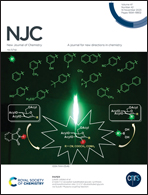Fluorinated 2,3-diaminophenazines: synthesis, mechanism of formation, and properties†
Abstract
A series of new fluorinated 2,3-diaminophenazines were obtained by the oxidation of fluorinated o-phenylenediamines with iron trichloride in water acidified with HCl. Isomeric 2,3-diaminophenazines with F atoms in both benzene fragments were obtained when o-phenylenediamines contained an F atom at the ortho-position with respect to the amino group. The ratio of isomers depends on the number and position of F atoms in o-phenylenediamines. DFT calculations for the formation of fluorinated 2,3-diaminophenazines in question were consistent with the experimentally observed ratio of the isomers. The formation of the predominant isomer was attributed to the action of the amino group with the highest N-charge of protonated o-phenylenediamines at the most electron-depleted position of the most stable protonated diimine. New compounds were characterized using various spectroscopy techniques (IR, UV, 1H, 19F, 13C NMR, and mass). Fluorinated 2,3-diaminophenazines are heat-resistant and fluoresce from green to red depending on the number of F atoms in the ring bearing amino groups. The presence of F atoms decreases the emission intensity but at the same time bathochromically shifts the fluorescence maximum. In the absence of the F atom in the ring bearing amino groups, fluorinated 2,3-diaminophenazines exhibited fluorescence intensities comparable to those of a non-fluorinated analog.



 Please wait while we load your content...
Please wait while we load your content...